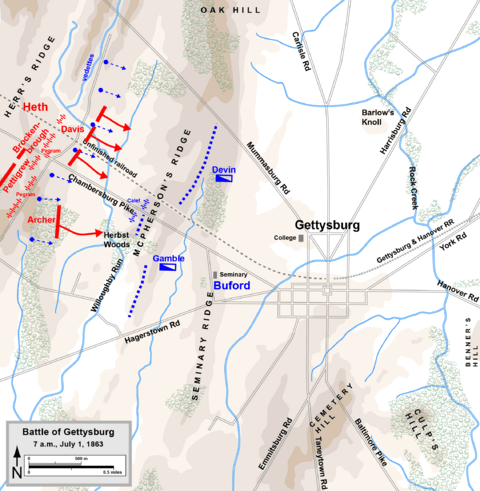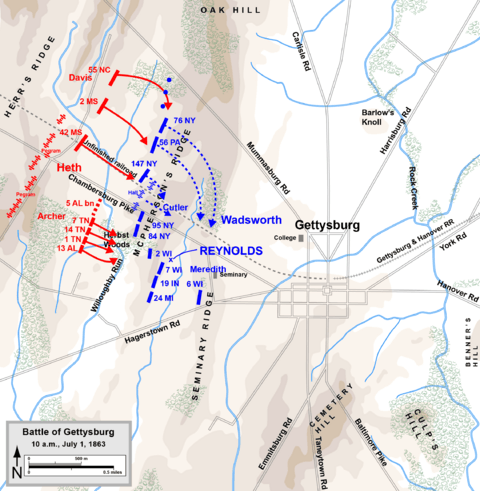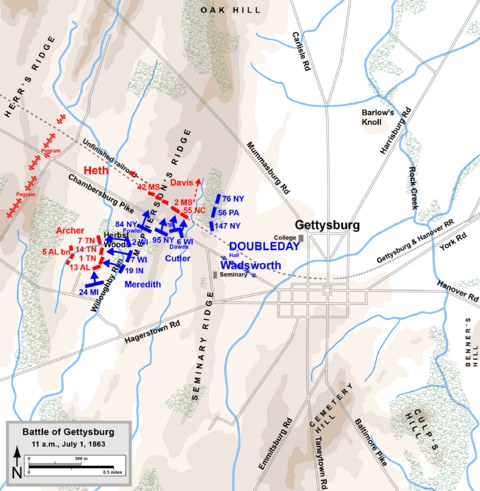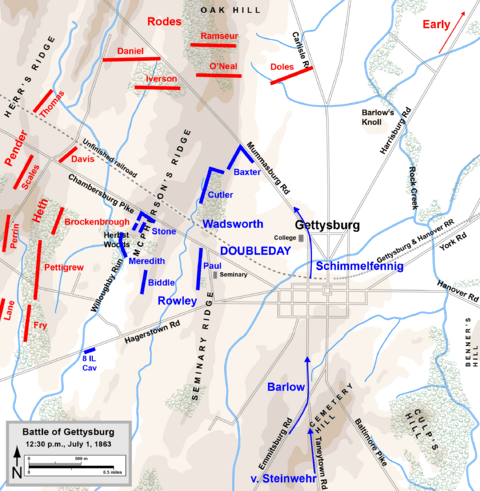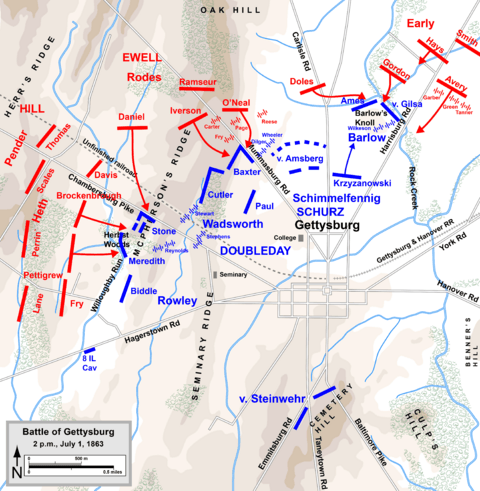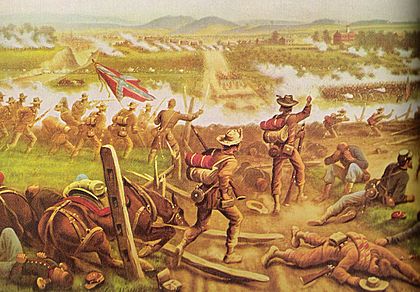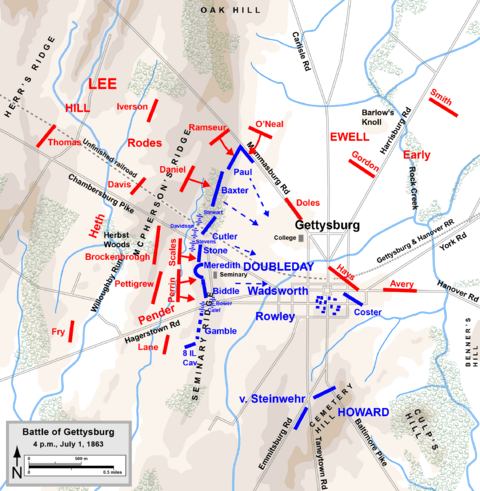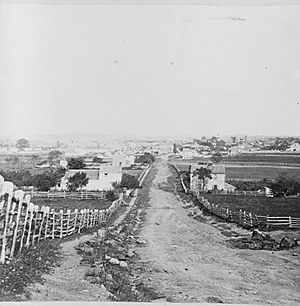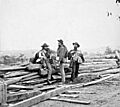Battle of Gettysburg, first day facts for kids
The first day of the Battle of Gettysburg was a major fight during the American Civil War. It happened on July 1, 1863. The battle started when small groups of soldiers from the Confederate army, led by Robert E. Lee, met soldiers from the Union army, led by George Meade. What began as a small clash quickly grew into a huge battle. The Union forces, who were outnumbered, had to retreat to higher ground south of Gettysburg, Pennsylvania.
The first day's battle happened in three main parts as more soldiers arrived. In the morning, Confederate soldiers under Maj. Gen. Henry Heth were slowed down by Union cavalry (soldiers on horseback) led by Brig. Gen. John Buford. When Union infantry (foot soldiers) arrived, led by Maj. Gen. John F. Reynolds, they pushed back the Confederate attacks. Sadly, General Reynolds was killed during this time.
By early afternoon, more Union soldiers arrived, forming a line around the west and north of Gettysburg. The Confederate army, led by Lt. Gen. Richard S. Ewell, launched a huge attack from the north. Union lines held strong for a while, but one part of their defense, called Barlow's Knoll, was eventually taken over.
The final part of the battle saw the Confederates attack again from the north and west. Heavy fighting near the Lutheran Theological Seminary and on Oak Ridge caused the Union line to break. Some Union soldiers fought their way back through the town, losing many men and prisoners. Others simply ran. They found strong defensive spots on Cemetery Hill and waited for more attacks. Even though General Lee gave orders to take these high grounds "if possible," General Ewell decided not to attack. Historians still wonder how the battle might have changed if he had attacked.
Contents
Background of the Battle
What was the Military Situation?
The Battle of Gettysburg was a key moment in the Gettysburg Campaign. It was a very important battle during the Civil War.
Who Fought in the Battle?
The Union Army
The Union army was made up of many different units. You can learn more about them in the Gettysburg Union order of battle article.
The Confederate Army
The Confederate army also had many different groups of soldiers. More details are in the Gettysburg Confederate order of battle article.
Morning Fights
How Buford's Cavalry Delayed the Confederates
On the morning of July 1, Union cavalry, led by Brig. Gen. John Buford, were waiting for Confederate foot soldiers. The day before, a small group of Confederates had met Union soldiers. They thought they were just local militia, not trained army cavalry.
General Buford knew that the high ground south of Gettysburg was very important. If the Confederates took it, it would be very hard for the Union army to push them out. He decided to use three ridges west of Gettysburg: Herr Ridge, McPherson Ridge, and Seminary Ridge. These ridges were good for slowing down the larger Confederate army. This would give Union foot soldiers time to arrive and set up defenses on Cemetery Hill, Cemetery Ridge, and Culp's Hill. Early that morning, General Reynolds, who was in charge of a part of the Union army, ordered his soldiers to march to Buford's location.
Confederate Maj. Gen. Henry Heth's division moved towards Gettysburg. Heth did not use cavalry and instead led with his artillery. Two groups of foot soldiers followed. About three miles west of town, around 7:30 a.m., Heth's soldiers met light resistance from Union cavalry. These cavalrymen were from Col. William Gamble's brigade. The first shot of the battle is said to have been fired by Lieutenant Marcellus Jones of the 8th Illinois Cavalry. Buford's 2,748 cavalrymen were soon facing 7,600 Confederate foot soldiers.
Gamble's men fought hard and used delaying tactics from behind fences. They used special rifles called carbines that could fire two or three times faster than the Confederates' rifles. Also, Union soldiers could reload their rifles while staying hidden, which was a big advantage. The Confederates had to stand up to reload, making them easier targets. By 10:20 a.m., the Confederates had pushed the Union cavalry back to McPherson Ridge. Just then, the first Union foot soldiers arrived, led by Gen. Reynolds. He quickly talked with Buford and went back to bring more men forward.
Davis vs. Cutler: A Fierce Fight
The morning's fighting happened mostly on McPherson Ridge. To the north, an unfinished railroad bed had three shallow cuts in the ground. To the south were Willoughby Run and Herbst Woods. Brig. Gen. Lysander Cutler's Union soldiers fought against Davis's Confederate soldiers.
General Reynolds personally led his soldiers into position. As he rode his horse near Herbst Woods, shouting to his men, he was instantly killed by a bullet. Maj. Gen. Abner Doubleday then took command of the Union I Corps.
On the right side of the Union line, three of Cutler's regiments were attacked by Davis's soldiers before they could get into position. Davis's line was longer than Cutler's, making the Union position hard to hold. Cutler's regiments were ordered back to Seminary Ridge. One regiment, the 147th New York, lost 207 out of 380 men in under 30 minutes. Some of Davis's winning soldiers then turned towards Union positions south of the railroad or moved east towards Seminary Ridge.
Archer vs. Meredith: The Iron Brigade
South of the road, Archer's Confederate men expected an easy fight. But they were surprised to see the black hats of the famous Iron Brigade. These Union soldiers from Indiana, Michigan, and Wisconsin were known as tough fighters. As the Confederates crossed Willoughby Run and climbed into Herbst Woods, the longer Union line surrounded them on their right.
Brig. Gen. Archer was captured during this fighting. He was the first general in Robert E. Lee's army to be captured. Private Patrick Moloney of the 2nd Wisconsin captured him. Moloney was killed later that day, but he received the Medal of Honor for his brave act.
The Railroad Cut Battle
Around 11 a.m., General Doubleday sent his reserve soldiers, the 6th Wisconsin, north towards Davis's disorganized Confederate group. The Wisconsin men stopped at a fence and fired, which stopped Davis's attack. Many Confederates took cover in the unfinished railroad cut. The 6th Wisconsin joined two New York regiments. These three regiments charged the railroad cut, where Davis's men were hiding. The cut was too deep to be a good firing spot, up to 15 feet deep. Also, their general, Davis, was missing.
The Union soldiers faced heavy fire as they charged. The 6th Wisconsin's American flag fell at least three times. When the Union men reached the cut, fierce hand-to-hand fighting broke out. Union soldiers could fire from both ends of the cut, and many Confederates thought about surrendering. Colonel Rufus Dawes of the 6th Wisconsin called out for the Confederate commander. Major John Blair of the 2nd Mississippi stood up and surrendered.
Even with this surrender, fighting continued for a few more minutes. Many Confederates escaped back to Herr Ridge. The three Union regiments lost many men, but they had stopped Davis's attack. This also prevented Davis's men from attacking the Iron Brigade from behind. The Confederate group was so badly hurt that they could not fight much for the rest of the day.
Midday Break
By 11:30 a.m., the battlefield was quiet for a short time. On the Confederate side, Henry Heth was in a tough spot. General Lee had told him not to start a big battle until all of his army was together. But Heth's trip to Gettysburg, supposedly to find shoes, had started a major fight, and he was losing. By 12:30 p.m., his other two brigades arrived, along with Maj. Gen. Dorsey Pender's division.
More Confederate soldiers were on their way. Two divisions from Lt. Gen. Richard S. Ewell's corps were coming from the north. Maj. Gen. Robert E. Rodes's soldiers marched down the Carlisle Road. Maj. Gen. Jubal A. Early's soldiers came on the Harrisburg Road. Union cavalry scouts north of town saw both groups moving.
On the Union side, General Doubleday reorganized his lines as more of his soldiers arrived. The XI Corps arrived from the south before noon. Maj. Gen. Oliver Otis Howard was on a rooftop in town when he heard that General Reynolds had been killed. Howard was now in command of all Union forces on the field. He quickly sent messages asking for more soldiers to come.
Howard sent his first XI Corps division north to link up with the I Corps. Another division was placed on Barlow's Knoll. The third division was placed on Cemetery Hill with artillery. This was to hold the hill as a safe place if Union troops had to retreat.
However, Rodes's Confederates reached Oak Hill first. So, the XI Corps had to set up in the open fields north of town. Howard's defensive line in the north was not very strong. His XI Corps had only 8,700 soldiers and had recently been defeated at the Battle of Chancellorsville. The land they were on was not good for defense. Howard hoped that more Union soldiers would arrive soon to help.
Afternoon Attacks
In the afternoon, fighting continued both west and north of Gettysburg. General Ewell, seeing Howard's troops setting up, thought they were about to attack. He decided to attack, even though General Lee had told him not to start a big battle.
Rodes Attacks from Oak Hill
Rodes first sent three brigades south against the Union lines. Two of these attacks, by O'Neal and Iverson, did not go well. They faced six experienced Union regiments hidden behind a stone wall. The Union soldiers fired heavily from less than 100 yards away, causing over 800 casualties among Iverson's 1,350 North Carolinians. This area is now known as "Iverson's Pits."
Baxter's Union brigade was tired and out of ammunition. At 3:00 p.m., they pulled back, and another brigade took their place. Rodes then sent in his two reserve brigades. One of their commanders, Brig. Gen. Gabriel René Paul, was shot in the head and permanently blinded.
Another Confederate brigade tried to break the Union line to the southwest. They met strong resistance from Col. Roy Stone's Pennsylvania "Bucktail Brigade" near the railroad cut. The fierce fighting eventually stopped.
Heth Renews His Attack
General Lee arrived on the battlefield around 2:30 p.m. Seeing a major attack happening, he allowed General Hill to restart his morning attacks. Heth's division attacked again with two fresh brigades.
Pettigrew's Brigade, the largest in the Confederate army, pushed back the Iron Brigade in some of the war's fiercest fighting. The Iron Brigade was forced out of the woods and had to fall back towards the Lutheran Theological Seminary. General Meredith was wounded when his horse fell on him.
Casualties were very high that afternoon. The 26th North Carolina regiment, which started with 839 men, had only about 212 left after the first day. Their commander was fatally wounded. By the end of the three-day battle, they had only about 152 men standing, the highest casualty rate for any regiment in one battle. One Union regiment, the 24th Michigan, lost 399 out of 496 men.
General Heth was also wounded in the head, but he was saved because he had paper stuffed in his hat. He was unconscious for over 24 hours and could not command for the rest of the battle. This meant he could not push Pender's division forward to help.
Early Attacks the XI Corps
Maj. Gen. Oliver O. Howard of the XI Corps had a tough job defending the wide, open farmland north of town. He had only two divisions to cover a large area. Historians have criticized his decision to place his line too far forward, making his right side vulnerable.
To make things harder, Brig. Gen. Francis C. Barlow advanced even further north, taking a small hill called Blocher's Knoll (now Barlow's Knoll). He wanted to stop Confederate artillery from using it. This position created a weak spot in the Union line that could be attacked from many sides.
Richard Ewell's second division, led by Jubal Early, swept down the Harrisburg Road. They attacked with a battle line almost a mile wide. Early started with a huge artillery bombardment. Brig. Gen. John B. Gordon's Confederate soldiers attacked Barlow's Knoll head-on, while other brigades swung around the exposed Union flank. The Union defenders were overwhelmed and retreated in disorder. Barlow, trying to rally his troops, was shot and captured.
The left side of the XI Corps also faced heavy artillery fire and infantry attacks. They fell back in confusion towards the town. A desperate counterattack by the 157th New York was surrounded and suffered huge losses.
General Howard sent an artillery battery and an infantry brigade to help, but they were also overwhelmed. They provided valuable cover for the retreating soldiers but at a high cost. The XI Corps collapsed by 4 p.m., after less than an hour of fighting. They suffered 3,200 casualties, about half the number they sent forward.
Rodes and Pender Break Through
Rodes's earlier attack had stalled, but he launched his reserve brigade again. Daniel's Brigade also resumed its attack. This time, Rodes was more successful because Early coordinated an attack on his flank.
In the west, Union troops had fallen back to the Seminary and quickly built defenses. Dorsey Pender's division of Hill's Corps moved through Heth's tired men around 4:00 p.m. to finish off the Union I Corps survivors. Brig. Gen. Alfred M. Scales's brigade attacked first. His 1,400 North Carolinians were almost wiped out by one of the fiercest artillery barrages of the war. Twenty guns fired shells and canister shot into the approaching brigade, leaving only about 500 men standing.
The attack continued in the center, where Col. Abner M. Perrin's South Carolina brigade charged rapidly. Perrin led his men to a weak spot in the Union defenses, a 50-yard gap. They broke through, surrounding the Union line. By 4:30 p.m., the Union position was impossible to hold. Union soldiers could see the XI Corps retreating from the northern battle, chased by many Confederates. General Doubleday ordered a retreat east to Cemetery Hill.
The Union Retreat
The retreat of Union units is not entirely clear. Each corps blamed the other. Some say the collapse at Barlow's Knoll caused a chain reaction. Others say both Barlow's line and the Seminary defense broke at the same time. General Howard told General Meade that his corps had to retreat only because the I Corps collapsed first. This made Doubleday and his men unhappy.
Union troops retreated in different ways. Some brigades from Seminary Ridge moved slowly and in control. Colonel Wainwright's artillery was not told to retreat and found themselves alone. When Wainwright realized this, he ordered his gun crews to walk, not wanting to cause panic. As pressure grew, Wainwright ordered his 17 remaining guns to gallop down Chambersburg Street. A.P. Hill did not send any of his reserve troops to chase the retreating Union soldiers, which was a big missed chance.
Near the railroad cut, Daniel's Brigade attacked again, and almost 500 Union soldiers surrendered. Paul's Brigade became very isolated, and General Robinson ordered it to withdraw. He ordered the 16th Maine to hold its position "at any cost" as a rear guard. The regiment fought fiercely, giving enough time for the rest of the brigade to escape. The 16th Maine started the day with 298 men but had only 35 survivors after this action.
For the XI Corps, it was a sad reminder of their retreat at Chancellorsville. Chased by Confederates, they crowded the streets of Gettysburg. Hand-to-hand fighting broke out in places. Some soldiers tried to avoid capture by hiding in basements. General Alexander Schimmelfennig hid behind a woodpile for the rest of the three-day battle. The only advantage XI Corps soldiers had was that they knew the way to Cemetery Hill.
As Union troops climbed Cemetery Hill, they met Maj. Gen. Winfield Scott Hancock. General Meade, who was nine miles south of Gettysburg, heard that Reynolds had been killed. He immediately sent Hancock, his most trusted officer, to take command and decide if Gettysburg was a good place for a major battle.
When Hancock arrived on Cemetery Hill, he met Howard. Howard was senior, but he reluctantly let Hancock take charge. Hancock arrived after 4:00 p.m. and didn't command any units that day, but he took control of the Union troops arriving on the hill. He directed them to defensive positions with his strong personality. Hancock told Howard, "I think this the strongest position by nature upon which to fight a battle that I ever saw." Howard agreed, and Hancock declared, "Very well, sir, I select this as the battle-field."
Evening Decisions
General Lee also understood how strong Cemetery Hill could be for the Union army. He sent orders to Ewell to "carry the hill occupied by the enemy, if he found it practicable." Ewell chose not to attack. One reason might have been that his men were tired from the day's fighting. Another reason was the difficulty of attacking the hill through the narrow streets of Gettysburg. Ewell asked A.P. Hill for help, but Hill felt his corps was too tired.
Lee's order has been criticized because it gave Ewell too much freedom. Many historians wonder how the more aggressive Stonewall Jackson would have acted if he had been there. They think the battle might have gone very differently with Confederate artillery on Cemetery Hill.
Most of the rest of both armies arrived that evening or early the next morning. On the Union side, Meade arrived after midnight. The II Corps and III Corps took positions on Cemetery Ridge. Only the VI Corps was still far away.
The first day at Gettysburg was more than just a warm-up for the bloody second and third days. It ranks as the 23rd-largest battle of the war by number of soldiers involved. About a quarter of Meade's army (22,000 men) and a third of Lee's army (27,000) fought. Union casualties were almost 9,000, while Confederate casualties were slightly over 6,000.
Images for kids



